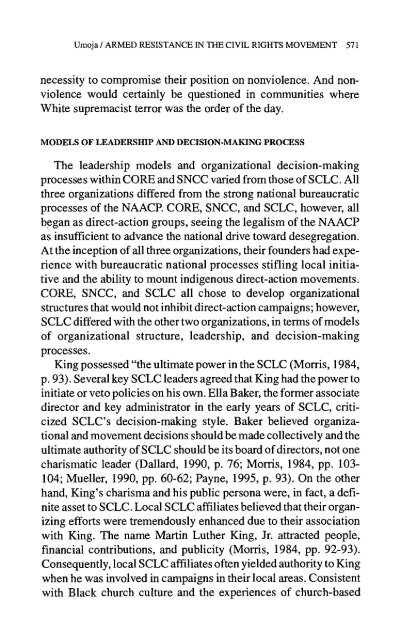MXGM Self-Defence Manual
MXGM Self-Defence Manual
MXGM Self-Defence Manual
Create successful ePaper yourself
Turn your PDF publications into a flip-book with our unique Google optimized e-Paper software.
Umoja / ARMED RESISTANCE IN THE CIVIL RIGHTS MOVEMENT 571<br />
necessity to compromise their position on nonviolence. And nonviolence<br />
would certainly be questioned in communities where<br />
White supremacist terror was the order of the day.<br />
MODELS OF LEADERSHIP AND DECISION-MAKING PROCESS<br />
The leadership models and organizational decision-making<br />
processes within CORE and SNCC varied from those of SCLC. All<br />
three organizations differed from the strong national bureaucratic<br />
processes of the NAACP. CORE, SNCC, and SCLC, however, all<br />
began as direct-action groups, seeing the legalism of the NAACP<br />
as insufficient to advance the national drive toward desegregation.<br />
At the inception of all three organizations, their founders had experience<br />
with bureaucratic national processes stifling local initiative<br />
and the ability to mount indigenous direct-action movements.<br />
CORE, SNCC, and SCLC all chose to develop organizational<br />
structures that would not inhibit direct-action campaigns; however,<br />
SCLC differed with the other two organizations, in terms of models<br />
of organizational structure, leadership, and decision-making<br />
processes.<br />
King possessed "the ultimate power in the SCLC (Morris, 1984,<br />
p. 93). Several key SCLC leaders agreed that King had the power to<br />
initiate or veto policies on his own. Ella Baker, the former associate<br />
director and key administrator in the early years of SCLC, criticized<br />
SCLC's decision-making style. Baker believed organizational<br />
and movement decisions should be made collectively and the<br />
ultimate authority of SCLC should be its board of directors, not one<br />
charismatic leader (Dallard, 1990, p. 76; Morris, 1984, pp. 103-<br />
104; Mueller, 1990, pp. 60-62; Payne, 1995, p. 93). On the other<br />
hand, King's charisma and his public persona were, in fact, a definite<br />
asset to SCLC. Local SCLC affiliates believed that their organizing<br />
efforts were tremendously enhanced due to their association<br />
with King. The name Martin Luther King, Jr. attracted people,<br />
financial contributions, and publicity (Morris, 1984, pp. 92-93).<br />
Consequently, local SCLC affiliates often yielded authority to King<br />
when he was involved in campaigns in their local areas. Consistent<br />
with Black church culture and the experiences of church-based


